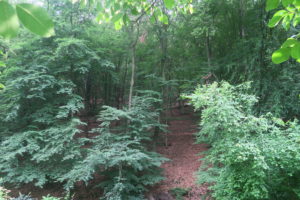General description of project area
Name of the project area: Mátraszőlősi Kis-Függő-kő
Surface area (ha): 72.970
EU protection status SPA: –
EU protection status SCI: NATURA 2000 Code HUBN20056
Other protection status according to national or regional legislation: East-Cserhát Landscape Protection Area
The main uses of the project site: The main land uses: Nature Conservation 100%
The ownership status: State property 100%

Scientific description of project area
The area is located 280-400 m a.s.l. on an andesite bedrock. From the low-flow streams up to the hill top it is covered with two blocks of 72-95 years old natural forests of 91G0*Pannonic woods with Quercus petraea and Carpinus betulus (46%), 91H0*Pannonian woods with Quercus pubescens (4%), 91M0 Pannonian-Balkanic turkey oak –sessile oak forests (49%) and some transition forests (1%). The two blocks are separated by aPinus nigra forest plantation and an abandoned pasture. The landscape around it comprises forests, maintained and abandoned grasslands and gardens. In the northern part of the area, there are some remains of limestone flora including Cephalanthera rubra, Epipactis microphylla, Epipactis helleborine. The rocky ridge is covered by 40A0*Subcontinental peri- Pannonic scrub (0,1%) including Spiraea media and Cotoneaster integerrimus. The clearings of the forests are covered with 6240*Sub-Pannonic steppic grasslands (0,3%) including Achillea crithmifolia, Carduus collinus. There wasn’t any forestry operation in the last 15-30 years, therefore, the area is enriched in a large number of protected species such as Adonis vernalis, Inula oculus-christi, Iris variegata, Plomis tuberosa and Sorbus domestica. Some scattered invasive Robinia pseudoacacia can also be found in the project area.
Animals of the area:
- Mammals: Felis sylvestris
- Birds: Columba oenas, Caprimulgus europaeus Dryocopus martius, Dendrocopos medius, Ficedula albicollis, Picus canus, Pernis apivorus and Bubo bubo.
- Reptiles: Ablepharus kitaibelii fitzingeri and Podarcis muralis.
- Amphibians: Salamandra salamandra
- Beetles: Aesalus scarabaeoides, Cerambyx cerdo, Lucanus cervus and Ropalopus spinicorni.
- Butterflies: Dioszeghyana schmidtii, Marumba quercus, Neptis rivularis and Parnassius mnemosyne
Importance of the project area for biodiversity and/or for the conservation of the species /habitat types targeted at regional, national and EU level
Biodiversity is significant, with several rare and valuable plant and animal species. These are biogeographically important, habitat-specialist species with strong populations in the area. The different oak forest stands (91G0, 91H0, 91M0,) are very important habitats for several strictly protected species listed in the scientific description part and require proper nature conservation management. The age, stand structure, composition, mixture rate and dead wood of Pannonic woods with Quercus petraea and Carpinus betulus; Pannonian woods with Quercus pubescens and annonian- Balkanic turkey oak –sessile oak forests of the area, the presence of Subcontinental peri-Pannonic scrub and Sub-Pannonic steppic grasslands makes the area important from a biodiversity and EU point of view. The naturalness and biological diversity of the area can be relatively quickly improved by proper nature conservation management.
Flagship species in project area
Cerambyx cerdo, Salamandra salamandra, Dryocopus martius